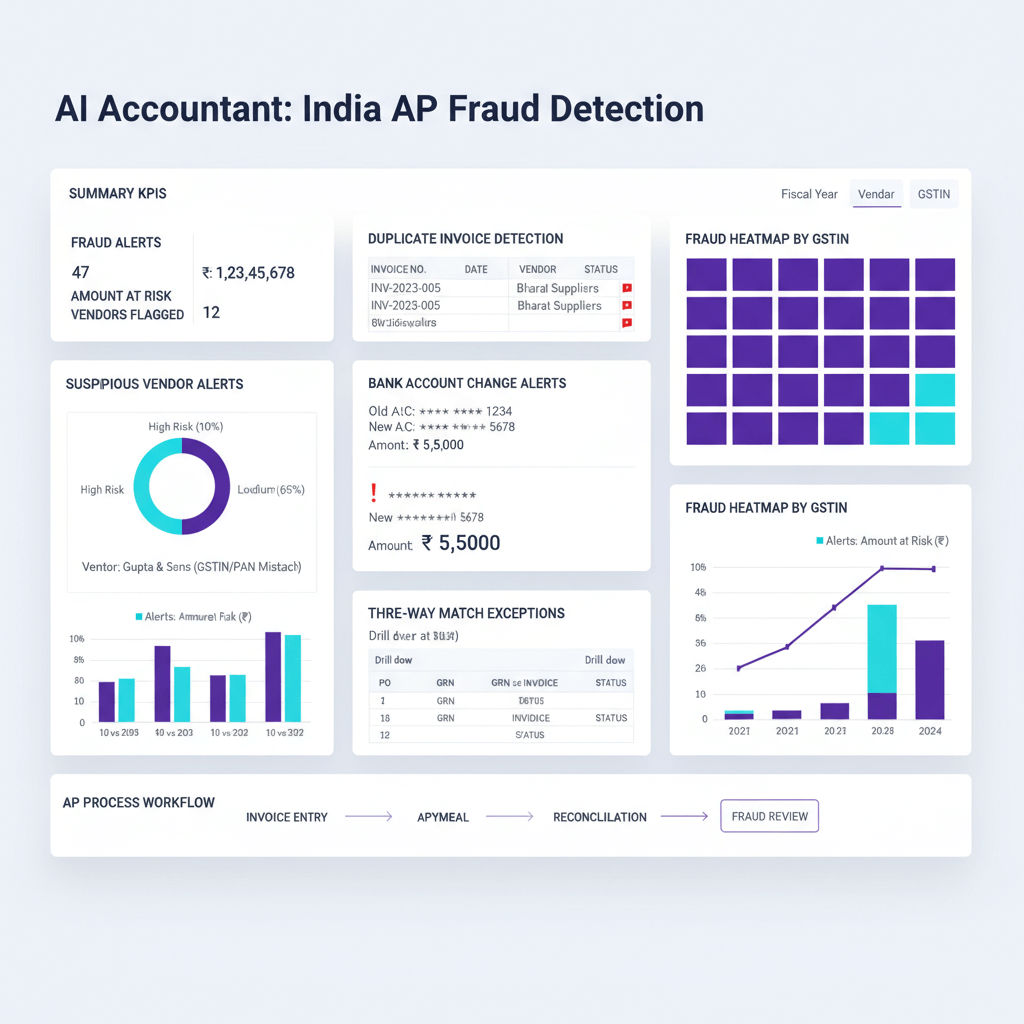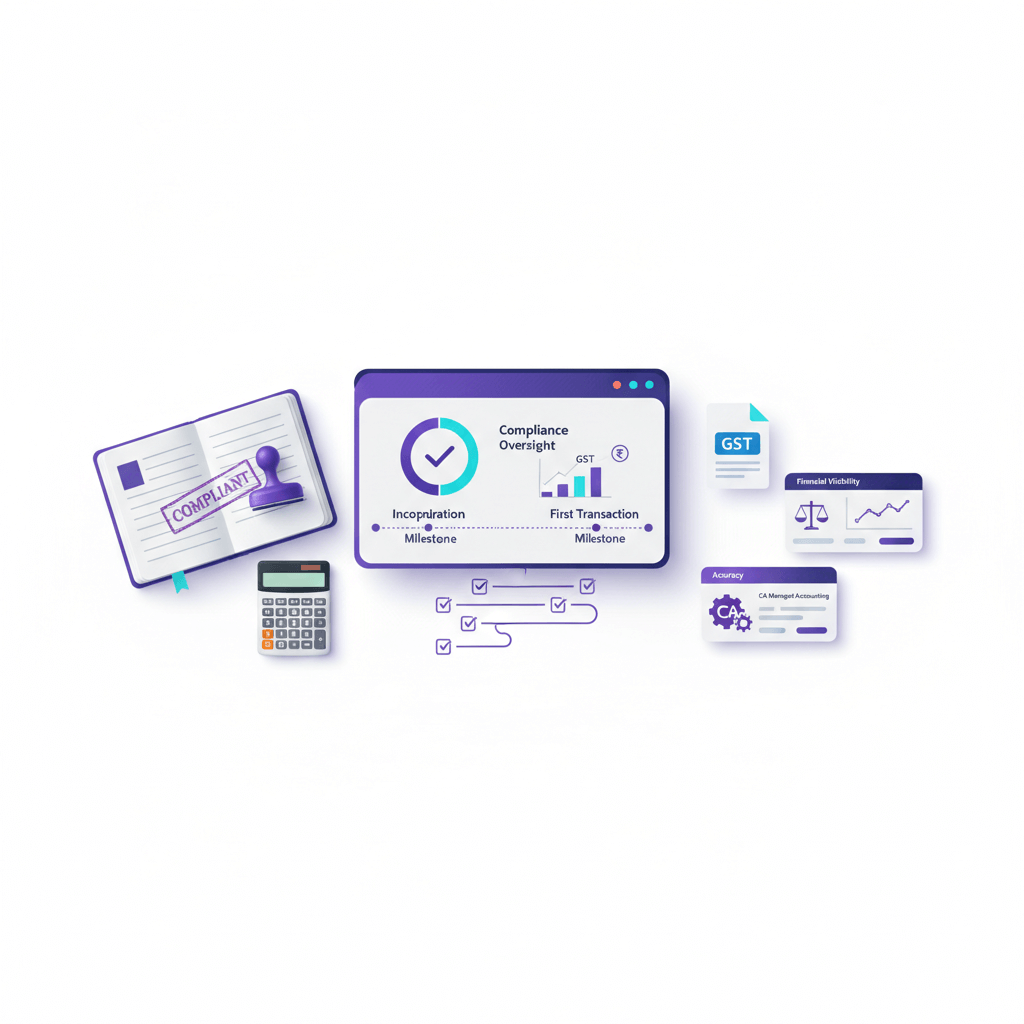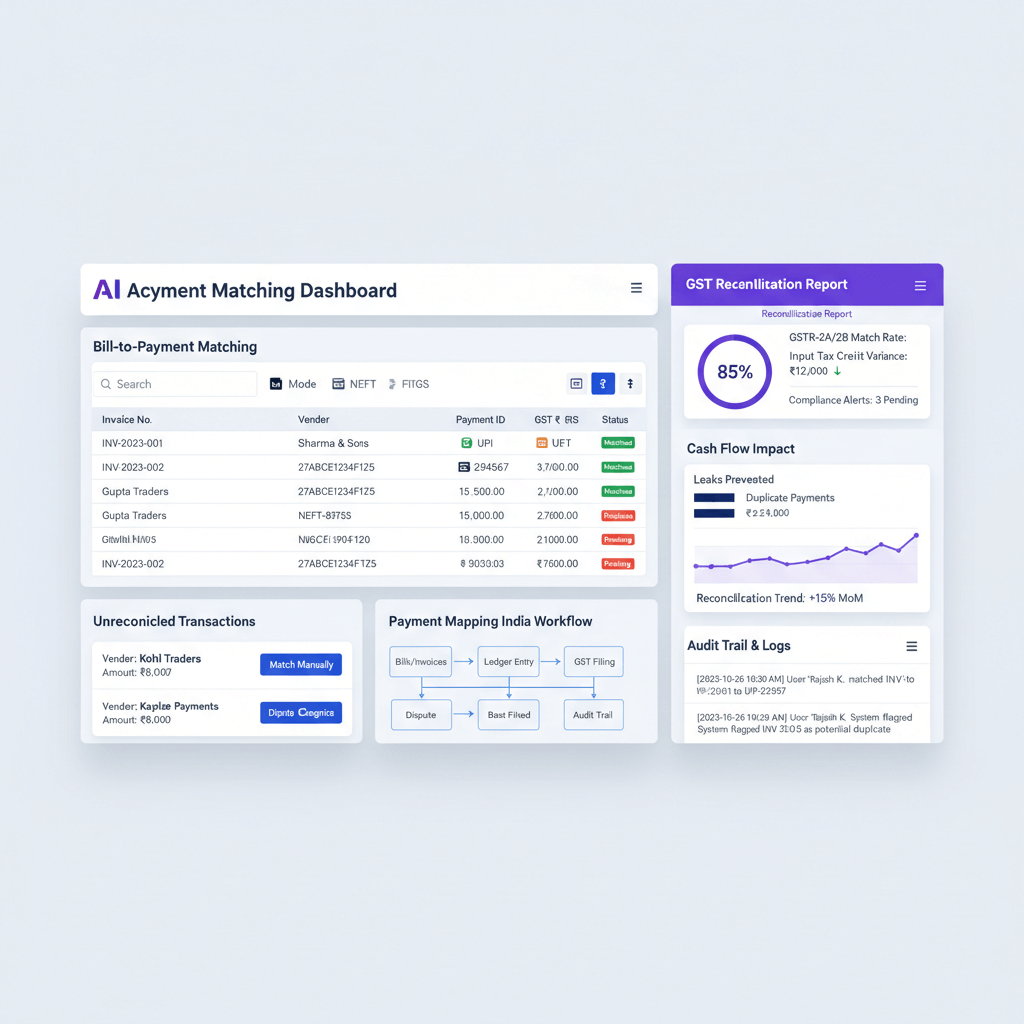Key takeaways
- Build a consistent, investor-ready management reporting package that founders can update in hours, not days, and use it to make faster decisions.
- Anchor your board deck on a reliable monthly close, automate reconciliations, and link every metric to an accountable owner and next step.
- Focus on metrics that signal growth quality, cash discipline, and business health, especially India-first indicators like GST, TDS, and working capital.
- Automate data ingestion, ledger sync, and anomaly detection to cut close time from 10 days to 3, while improving accuracy and trust.
- Tell a clear story, translate numbers into actions for non-finance teams, and maintain a KPI glossary to prevent metric drift.
- Start simple, ship a working system in 7 days, then scale with consolidation, predictive cash flow, and audit-ready trails as you grow.
Table of contents
- Why management reporting packages matter for Indian startups
- What makes up a management reporting package
- The monthly finance deck template that actually works
- Metrics that matter to investors in the Indian context
- Board reporting automation, from chaos to clarity
- Financial storytelling for non-finance teams
- Building your management reporting system in 7 days
- Common pitfalls that derail founder reporting
- Downloadable templates and implementation resources
- Advanced automation strategies for scaling startups
- Making your numbers tell a compelling story
- FAQ
Why management reporting packages matter for Indian startups
Picture this, it is 11 PM before a board meeting, and you are wrangling spreadsheets, mismatched ledgers, and unexplained burn. A strong management reporting package turns that chaos into clarity, it keeps investors aligned, and helps you run the business with confidence.
Investors want proof of cash discipline, growth quality, and decision velocity. In India, they are also watching your controls around GST compliance, TDS reconciliation, and working capital management. The usual fire drills, from last-minute decks to bank to ledger data inconsistencies, erode credibility.
Think of your reporting package as your primary investor communication tool, consistent in format, rigorous in numbers, and explicit in actions.
If you do this right, your package doubles as your operational dashboard too, building financial intelligence you use daily, not just board-meeting cosmetics. For a helpful primer, see MIS reports for startups.
What makes up a management reporting package
A founder-grade package includes a finance deck, KPI pack, cash summary, risk register, and action tracker, all in a consistent monthly format. Monthly gives depth, mid-month flash gives timely signal, quarterly expands strategy and scenarios without reinventing the wheel.
- Finance deck with P&L, cash, balance sheet highlights, unit economics
- KPI pack with definitions and trends
- Cash summary with runway, sensitivities, and collections plan
- Risk register with mitigation owners and deadlines
- Action tracker with status and next steps
Consistency beats complexity, and templates beat recollection. For additional context, explore MIS reports for startups.
The monthly finance deck template that actually works
Executive summary
Thirty-second story, highlights, asks, and headline numbers, revenue run rate, burn, runway, critical ops changes.
P&L walkthrough
Actuals versus plan, margin trends, and variance drivers. If gross margin dipped 5%, say if it was mix, pricing, or input cost inflation.
Cash flow and runway
Burn trends, runway, and sensitivity. Use your runway calculations to show scenarios, and model seasonal cash flow patterns and working capital swing.
Balance sheet highlights
Working capital, with accounts receivable and accounts payable breakdowns. Call out GST input credit positions.
India-specific compliance updates
Status of GSTR‑1 automation and GSTR‑2B reconciliation, plus TDS hygiene.
Unit economics and pipeline
Show how revenue engine quality translates to profit, tying operational metrics and financial performance clearly.
Make it scannable, use clear trend lines, traffic-light statuses, and annotations that explain what happened, why, and what you will do next.
For more examples, see MIS reports for startups.
Metrics that matter to investors in the Indian context
Growth quality
ARR and MRR growth, gross and net margin trends, NRR and GRR, CAC and payback, sales efficiency.
Discipline and liquidity
Burn multiple, operating cash flow, runway scenarios, working capital needs, DSO, DPO, cash conversion cycle. Aim for burn multiple under 2x, and explain your path back if not.
Health and India-first indicators
Customer concentration, AR and AP aging, GST and TDS flags, FX exposure. As a rule of thumb, target DSO under 45 days for Indian B2B, SaaS gross margins above 70%, churn under 5% monthly for B2B, a cash conversion cycle under 60 days.
Always connect movement to action. Do not just report that DSO rose, state which segments drove it, and your collections plan.
Board reporting automation, from chaos to clarity
Manual does not scale, automation compounds. It cuts manual work, slashes errors, and frees time for analysis.
Build your automation loop
- Start with clean ingestion using a bank statement OCR tool guide and bank statement OCR software in India, then map transactions to your ledger consistently.
- Enable one-click sync with Tally Prime automation and Zoho Books automation tips, so statutory books remain the source of truth while powering management dashboards.
- Use anomaly alerts, including detect duplicate bank transactions and hidden bank charges detection India, and keep an audit trail.
Tools to consider
- AI Accountant for automated bookkeeping and reporting tailored to Indian banks and GST
- QuickBooks, Xero, FreshBooks, Zoho Books, Tally
The cadence, checklist close, auto-refresh dashboards, export to deck, and annotate insights. Many CA firms report a reduction from 10-day closes to 3-day closes once this is in place.
Explore more context via MIS reports for startups.
Financial storytelling for non-finance teams
Your package is a bridge, not a barrier. Translate numbers to actions that marketing, sales, product, and ops can execute.
From metrics to moves
- Show channel-wise CAC and payback so marketing shifts budget where returns are strongest.
- Link discounting and deal size to margins so sales prioritizes profitable segments.
- Use inventory and receivables signals to adjust procurement or collections sprints.
The narrative that sticks
Context, Signal, Implication, Owner, Deadline. For example, context DSO was 35 days, signal now 52, implication an extra 2.5 months of working capital is locked, owner sales ops, deadline new terms training deployed by month-end.
Eliminate vanity metrics, build a KPI glossary, and give team-specific views that spotlight leading indicators.
Building your management reporting system in 7 days
Day 1 connect banks and systems, set exports where APIs do not exist.
Day 2 define metric formulas and data sources, prevent inconsistencies before they start.
Day 3 assemble the deck template with placeholders, lock the structure.
Day 4 craft variance narratives, write exemplar explanations for common scenarios.
Day 5 dry run with last month’s data, gather feedback, fix gaps.
Day 6 document close checklists, validation steps, and the timeline.
Day 7 schedule automated pulls, dashboard refreshes, and alerts, then set a monthly rhythm.
Common pitfalls that derail founder reporting
- Measuring too much, if it does not drive a decision or have an owner, drop it.
- Mixing booked and cash, choose one per view, label clearly, be consistent.
- Ignoring GST and TDS hygiene, embed GST reconciliation and TDS automation into your monthly close.
- Static decks without accountability, every metric needs an owner, target, and date.
- Overlooking seasonality, bake business rhythms into explanations and forecasts.
- Overcomplicating, keep the core deck to 12–15 slides, push deep dives to the appendix.
Downloadable templates and implementation resources
Monthly finance deck template, executive summary, P&L with variances, cash and runway, balance sheet working capital, India compliance, unit economics, and forward guidance.
Metrics dictionary, define revenue recognition, customer counts, churn, LTV, CAC, burn, runway, working capital, and compliance metrics, include sources and edge cases.
Monthly close checklist, bank reconciliation, AR and AP review, revenue and deferrals, expense accruals, GST and TDS tie-outs, dashboard refresh, deck preparation.
Dashboard templates, compliance tracker, cash trends, AR and AP aging, runway scenarios, unit economics by segment.
Success metrics, close time, categorization accuracy, stakeholder clarity, and decision speed. For benchmark ideas, review MIS reports for startups.
Advanced automation strategies for scaling startups
Multi-entity consolidation, automate eliminations, inter-company, and provide both consolidated and standalone views.
Predictive cash flow, scenario models driven by customer payment patterns, supplier terms, inventory turnover, and AI-powered cash flow forecasting India.
Automated variance analysis, teach the system seasonality, flag exceptions, and suggest priorities with reusable explanation templates.
Operational integrations, connect CRM, billing, inventory, HRIS, and project tools, automate revenue recognition and unit economics by customer or project.
Audit-ready trails, maintain line-of-sight from every board number back to source, using an audit-trail compliance tool guide.
Making your numbers tell a compelling story
Connect metrics to strategy. If your goal is capital efficiency, show how CAC, payback, working capital, and operating leverage are moving. Be candid about risks, with mitigation owners and timelines. Provide benchmark context, or show progress versus your own targets.
When investors see consistent, thoughtful financial communication, they gain confidence in your ability to scale efficiently, manage capital responsibly, and course-correct quickly.
Start simple, then compound. Your reporting discipline becomes an advantage in execution, board management, and fundraising. For ongoing profitability tracking, see the profitability analysis dashboard for SMBs.
FAQ
How should a CA structure a monthly founder report so that it is board-ready in India?
Use a consistent sequence, executive summary, P&L with variances, cash and runway sensitivities, working capital and compliance highlights, unit economics, and an action tracker with owners. Keep the core deck to 12–15 slides, ensure a clean GST and TDS tie-out, and map every key KPI to a definition in your glossary. Many firms accelerate this using AI Accountant for automated reconciliations and dashboard refreshes.
What is the fastest way to cut month-end close from 10 days to 3 without sacrificing control?
Automate bank ingestion with OCR tuned to Indian formats, sync ledgers from Tally or Zoho Books, run automated anomaly checks, and maintain a tight close checklist with ownership. Tools like AI Accountant can ingest PDFs and CSVs, map entries, and surface exceptions, letting CAs focus on review and narrative instead of data wrangling.
Which metrics do investors prioritize for Indian SaaS, and how should I present them?
Show ARR, MRR growth, NRR and GRR, gross margin, CAC and payback, burn multiple, and runway scenarios. Present trend lines, compare to plan, and explain drivers. Benchmarks such as DSO under 45 days and gross margins above 70% matter. An AI Accountant style dashboard can link pipeline shifts to margin and cash impact clearly.
How do I reconcile management reports with GST returns to avoid credibility gaps?
Embed a monthly GST reconciliation step that ties GSTR‑1 and GSTR‑3B to management P&L. Track input credits from 2B, document timing differences, and ensure any manual adjustments are logged with an audit trail. Use AI Accountant or similar tools to auto-flag mismatches and attach source documents for review.
What burn multiple is acceptable during growth, and how do I justify a higher number to the board?
Under 2x is a healthy target. If burn multiple exceeds that, justify with a time-bound plan, for example, front-loaded hiring, product launch, or expansion that compresses CAC and shortens payback in the next two quarters. Provide sensitivity scenarios and show how working capital initiatives, like AR collection sprints, improve the cash picture.
How can a CA standardize metric definitions across finance, sales, and marketing to avoid metric drift?
Create a KPI dictionary, define sources, formulas, exclusions, and edge cases, and publish it alongside the monthly deck. Lock versions, and store in a system that teams can reference. AI Accountant style data pipelines can enforce these definitions so dashboards and decks always compute KPIs the same way.
What is the recommended cadence for flash updates versus full monthly packages?
Use a mid-month flash for signal, revenue trajectory, top variances, cash runway update, and critical risks. Keep detailed analysis for the month-end package. This rhythm keeps investors informed without noise, and it reduces surprises in the board meeting.
How do I present AR, AP, and working capital so the board can act on it?
Show AR and AP aging buckets, top 10 customers and suppliers by exposure, and changes month over month. Link DSO and DPO to runway, quantify how a 10-day improvement frees cash, and assign owners to collection and payables strategies. AI Accountant dashboards can highlight delinquent accounts and simulate cash-impact scenarios.
What controls should I add so automated reporting stays audit-ready?
Maintain an end-to-end audit trail for every transformation, variance alerts with documented explanations, locked metric definitions, role-based review checklists, and evidence attachments for reconciliations. Automating bank feeds, GST tie-outs, and anomaly detection with AI Accountant helps you preserve traceability for audits and diligence.
How do I align narrative with numbers so non-finance leaders actually change behavior?
Use the Context, Signal, Implication, Owner, Deadline framework. Replace generic charts with one insight per slide, and state the next decision explicitly. For example, “CAC rose 18% in paid search, shift 25% of spend to organic and partner channels, owner CMO, by the 15th.” AI Accountant style annotations inside dashboards make these calls to action hard to miss.
What does a 7-day implementation plan look like for a first-time founder using an AI accounting tool?
Day 1 connect banks and accounting, Day 2 define metrics, Day 3 assemble the deck, Day 4 write variance playbooks, Day 5 dry run, Day 6 document the close, Day 7 schedule automations and alerts. A tool like AI Accountant accelerates ingestion, reconciliation, and dashboard creation so you focus on analysis and communication.
How should I handle multi-entity consolidation for India holding structures?
Automate inter-company eliminations, standardize charts of accounts, and produce both consolidated and standalone views. Keep local statutory adjustments separate from management adjustments, and ensure FX translation and tax provisioning are transparent. An AI-enabled workflow can reduce manual consolidation work and error risk.

-01%201.svg)



